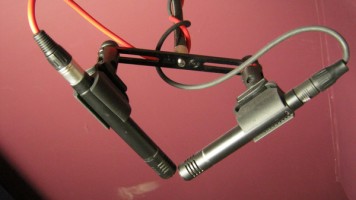Part 1 of 2
Acoustic Pianos vs. Electronic Keyboards

- fig. 1
Yeah, they both have black and white keys, but the similarities end there. Acoustic pianos are mechanical machines that produce sound when felt-tipped hammers hit strings held by a massive cast iron frame stretched across a wooden soundboard. Electronic keyboards are filled with analog circuits that synthesize sound waves, or digital circuits that mimic analog circuits or digital circuits that play back sampled sound waves … whatever. So how do you record them?
Acoustic Piano: Solo vs. Ensemble
For the longest time, pianists played only one type of music – classical. It wasn’t until a little over a hundred years ago that ragtime, jazz and then rock came along and adopted the piano for their own purposes. Okay, so why the history lesson? Because when we record the piano, we need to know how it’s going to be used in the song. Is it a classical or jazz piece that features solo piano? Or is it going to be blended in with other instruments? The answer to this question will start us down one of two different paths.
White Key Noise
We have a 1925 Ivers & Pond 6’ Grand Piano here at Night Train Studios. Some pianists fall madly in love with it, while others get up and walk away with a look of disgust. Guitarists out there know what we mean – every instrument is unique. Our Ivers & Pond has a wonderful jazzy bounce with bluesy warmth. But, it’s really noisy with squeaky pedals and clunky dampers – which is why classically trained pianists generally hate it. Record it solo and you’re going to capture all of its creaks, which detract from a performance. Yet as part of an ensemble, those undesirable sounds get masked and you can focus on the piano’s warm character.
Miking Techniques for Solo Piano
“Yeah, yeah” we hear you saying, “But what mics should I use and where should I put them?” That’s the secret isn’t it, to make any piano sound glorious? Fancy mics and magical mic location right? Sorry to let you down. We thought the same thing back in the day – “There must be one ultimate mic and sweet spot that makes every piano sound fantastic.” Sorry, there isn’t.
When you see a piano mic’d on stage during a concert, those mics are generally placed as close as possible to the piano’s sound board so as to capture more of the piano and less of the drums. It’s mic placement out of necessity. You don’t generally stick your head into a piano while it’s being played, because a piano is designed to be heard from a distance in a nice space. So whenever possible, if you are recording a solo piano performance, position your mics at least a few feet away and forbid anyone in the audience from coughing. And to find those “sweet” spots for your mics, try this: have the pianist start playing and slowly walk around the room with a finger in your ear. Why? Because that’s how microphones hear (unless you’re setting up a stereo mic, in which case just walk around with your hands in your pockets).
Don’t forget to walk hunched over and on your tippy toes too, because that elusive sweet spot may be residing at an unexpected elevation. How will you know when you find the sweet spot? For us it’s just a gut feeling – if it sounds good, go with it. If you want to get all anal about it, you can tape Xs on the floor and record test takes from multiple locations and A/B them – we used to do that, now we just trust our instincts. At this distance, you will need a lot of mic gain to get a hot enough level so you’ll want condenser mics with low self noise. If you’re on a budget we like the Blue Spark (mid-sized diaphragm) and the AKG C-1000S (small diaphragm). Both retail for $200, and you’ll also need a mixer/interface with quiet pre-amps.

fig. 2
Pianos in Space
Pianos sound great in stereo but you have to be careful. To record in stereo you obviously need two mics, but if you set them up incorrectly, you might run into comb filtering (some frequencies cancel out because they reach the mics at slightly different times). To save yourself some headaches, you can use a stereo pair of mics (two mics that are the same make and model) and set them up in a time tested stereo pattern. We recommend the X-Y pattern (fig 1) which yields a slightly narrower stereo field or the ORTF pattern (fig 2) which mimics the human head. Another option is to use a stereo mic, a microphone with a stereo capsule like the Rode NT4 (retail $550) which can make setup easier. Finally, you may want to consider a portable digital recorder, which can fit in the palm of your hand. The Tascam DR-2d ($150 retail) is a good choice if you’re on a tight budget, and the Zoom H4n ($300 retail) can accept an additional two external mics, allowing recording on four channels simultaneously,
In Part Two, we will discuss tuning, mixing, MIDI and volume limitations.
Zac Cataldo is a musician and owner/producer at Night Train Studios, a recording studio in Westford, MA. He is also co-owner of Black Cloud Productions, a music publishing company. Reach him at [email protected].
Brent Godin is a bassist/guitarist and engineer/producer at Night Train Studios and talent scout at Black Cloud Productions. Reach him at [email protected].
